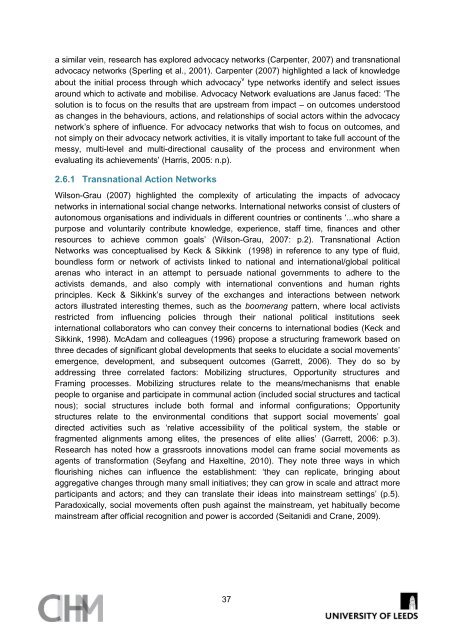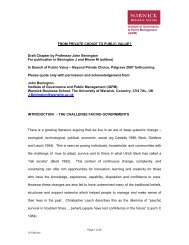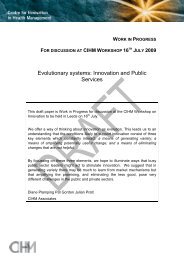Networks - a briefing paper for the Health Foundation - Centre for ...
Networks - a briefing paper for the Health Foundation - Centre for ...
Networks - a briefing paper for the Health Foundation - Centre for ...
- No tags were found...
You also want an ePaper? Increase the reach of your titles
YUMPU automatically turns print PDFs into web optimized ePapers that Google loves.
a similar vein, research has explored advocacy networks (Carpenter, 2007) and transnationaladvocacy networks (Sperling et al., 2001). Carpenter (2007) highlighted a lack of knowledgeabout <strong>the</strong> initial process through which advocacy v type networks identify and select issuesaround which to activate and mobilise. Advocacy Network evaluations are Janus faced: ‘Thesolution is to focus on <strong>the</strong> results that are upstream from impact – on outcomes understoodas changes in <strong>the</strong> behaviours, actions, and relationships of social actors within <strong>the</strong> advocacynetwork’s sphere of influence. For advocacy networks that wish to focus on outcomes, andnot simply on <strong>the</strong>ir advocacy network activities, it is vitally important to take full account of <strong>the</strong>messy, multi-level and multi-directional causality of <strong>the</strong> process and environment whenevaluating its achievements’ (Harris, 2005: n.p).2.6.1 Transnational Action <strong>Networks</strong>Wilson-Grau (2007) highlighted <strong>the</strong> complexity of articulating <strong>the</strong> impacts of advocacynetworks in international social change networks. International networks consist of clusters ofautonomous organisations and individuals in different countries or continents ‘...who share apurpose and voluntarily contribute knowledge, experience, staff time, finances and o<strong>the</strong>rresources to achieve common goals’ (Wilson-Grau, 2007: p.2). Transnational Action<strong>Networks</strong> was conceptualised by Keck & Sikkink (1998) in reference to any type of fluid,boundless <strong>for</strong>m or network of activists linked to national and international/global politicalarenas who interact in an attempt to persuade national governments to adhere to <strong>the</strong>activists demands, and also comply with international conventions and human rightsprinciples. Keck & Sikkink’s survey of <strong>the</strong> exchanges and interactions between networkactors illustrated interesting <strong>the</strong>mes, such as <strong>the</strong> boomerang pattern, where local activistsrestricted from influencing policies through <strong>the</strong>ir national political institutions seekinternational collaborators who can convey <strong>the</strong>ir concerns to international bodies (Keck andSikkink, 1998). McAdam and colleagues (1996) propose a structuring framework based onthree decades of significant global developments that seeks to elucidate a social movements’emergence, development, and subsequent outcomes (Garrett, 2006). They do so byaddressing three correlated factors: Mobilizing structures, Opportunity structures andFraming processes. Mobilizing structures relate to <strong>the</strong> means/mechanisms that enablepeople to organise and participate in communal action (included social structures and tacticalnous); social structures include both <strong>for</strong>mal and in<strong>for</strong>mal configurations; Opportunitystructures relate to <strong>the</strong> environmental conditions that support social movements’ goaldirected activities such as ‘relative accessibility of <strong>the</strong> political system, <strong>the</strong> stable orfragmented alignments among elites, <strong>the</strong> presences of elite allies’ (Garrett, 2006: p.3).Research has noted how a grassroots innovations model can frame social movements asagents of trans<strong>for</strong>mation (Seyfang and Haxeltine, 2010). They note three ways in whichflourishing niches can influence <strong>the</strong> establishment: ‘<strong>the</strong>y can replicate, bringing aboutaggregative changes through many small initiatives; <strong>the</strong>y can grow in scale and attract moreparticipants and actors; and <strong>the</strong>y can translate <strong>the</strong>ir ideas into mainstream settings’ (p.5).Paradoxically, social movements often push against <strong>the</strong> mainstream, yet habitually becomemainstream after official recognition and power is accorded (Seitanidi and Crane, 2009).37
















